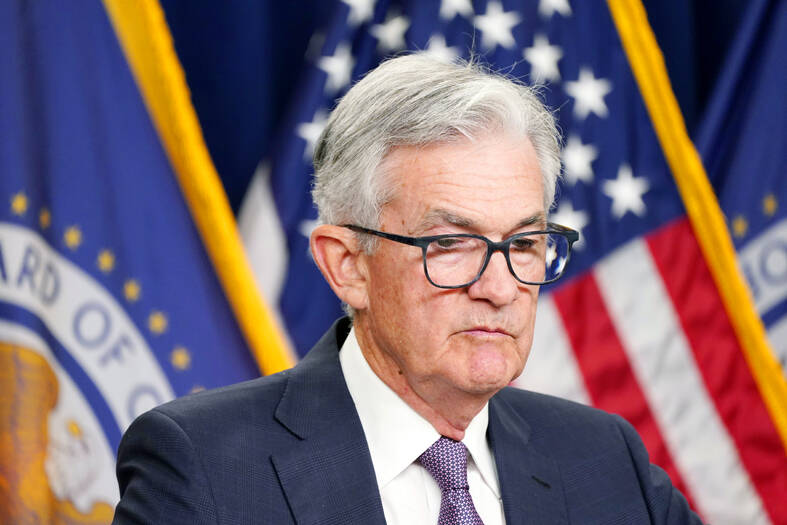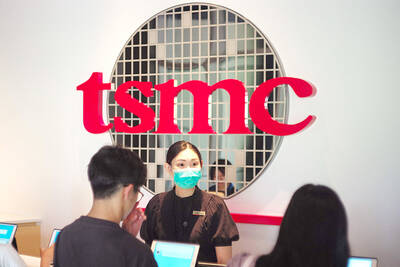US Federal Reserve officials gave their clearest signal yet that they are willing to tolerate a recession as a necessary trade-off for regaining control of inflation.
Policymakers, criticized for being too late to realize the scale of the US inflation problem, are moving aggressively to catch up. They raised interest rates by 75 basis points on Wednesday for the third time in a row, and forecast a further 1.25 percentage points of tightening before the end of the year.
That was more hawkish than expected by economists.

Photo: AP
Additionally, Fed officials cut growth projections and raised their unemployment outlook, while Fed Chair Jerome Powell spoke of the painful slowdown that is needed to curb price pressures running at the highest levels since the 1980s.
Fed officials are not explicitly projecting a recession, but Powell’s rhetoric about the rate hikes likely causing pain for workers and businesses has become progressively sharper in recent months.
At a news conference on Wednesday, Powell said that a soft landing with only a small increase in joblessness would be “very challenging.”
“No one knows whether this process will lead to a recession or if so, how significant that recession would be,” Powell told reporters after officials lifted the target range for their benchmark rate to between 3 percent and 3.25 percent.
“The chances of a soft landing are likely to diminish to the extent that policy needs to be more restrictive, or restrictive for longer. Nonetheless, we’re committed to getting inflation back down to 2 percent,” he said.
The median unemployment forecast among the 19 Fed officials is for 4.4 percent next year, remaining there through 2024, compared with the current rate of 3.7 percent.
However, even that new level might still be too low. Almost all participants said risks to their new forecasts were weighted to the upside. They projected interest rates reaching 4.4 percent this year and 4.6 percent next year, before moderating to 3.9 percent in 2024.
“We have always understood that restoring price stability while achieving a relatively modest increase in unemployment and a soft landing would be very challenging,” Powell said. “We have got to get inflation behind us. I wish there were a painless way to do that. There isn’t.”
Fed officials’ apprehension about their ability to bring down inflation is also evident in other projections. Even amid a new rate-hike path, officials still predict that inflation would not ease to their 2 percent target until 2025.
Powell told reporters several times that a softer labor market might be necessary to sufficiently bring down demand, but he also pointed to higher savings rates and more money at the state level indicating that the economy is still reasonably strong, a “good thing” that he said would make it more resistant to a significant downturn.
A number of economists raised their forecasts on Wednesday for where Fed rates would peak.
Bank of America Corp predicts rate hikes of 75 basis points in November, 50 basis points in December and two quarter-point increases early next year, bringing the benchmark rate to a target range of 4.75 percent to 5 percent. Economists at Societe Generale SA are calling for a “mild recession” in early 2024. Goldman Sachs Group Inc economists raised their forecast for the pace of Fed hikes.
Amherst Pierpont Securities LLC chief economist Stephen Stanley increased his terminal-rate outlook to 5.25 percent, saying he does not think the Fed’s inflation forecasts are realistic, and it will take increased tightening to bring price growth down.
“I see the first half of next year as a treacherous time for the Fed,” Stanley wrote in a note.

Taiwan Transport and Storage Corp (TTS, 台灣通運倉儲) yesterday unveiled its first electric tractor unit — manufactured by Volvo Trucks — in a ceremony in Taipei, and said the unit would soon be used to transport cement produced by Taiwan Cement Corp (TCC, 台灣水泥). Both TTS and TCC belong to TCC International Holdings Ltd (台泥國際集團). With the electric tractor unit, the Taipei-based cement firm would become the first in Taiwan to use electric vehicles to transport construction materials. TTS chairman Koo Kung-yi (辜公怡), Volvo Trucks vice president of sales and marketing Johan Selven, TCC president Roman Cheng (程耀輝) and Taikoo Motors Group

Among the rows of vibrators, rubber torsos and leather harnesses at a Chinese sex toys exhibition in Shanghai this weekend, the beginnings of an artificial intelligence (AI)-driven shift in the industry quietly pulsed. China manufactures about 70 percent of the world’s sex toys, most of it the “hardware” on display at the fair — whether that be technicolor tentacled dildos or hyper-realistic personalized silicone dolls. Yet smart toys have been rising in popularity for some time. Many major European and US brands already offer tech-enhanced products that can enable long-distance love, monitor well-being and even bring people one step closer to

RECORD-BREAKING: TSMC’s net profit last quarter beat market expectations by expanding 8.9% and it was the best first-quarter profit in the chipmaker’s history Taiwan Semiconductor Manufacturing Co (TSMC, 台積電), which counts Nvidia Corp as a key customer, yesterday said that artificial intelligence (AI) server chip revenue is set to more than double this year from last year amid rising demand. The chipmaker expects the growth momentum to continue in the next five years with an annual compound growth rate of 50 percent, TSMC chief executive officer C.C. Wei (魏哲家) told investors yesterday. By 2028, AI chips’ contribution to revenue would climb to about 20 percent from a percentage in the low teens, Wei said. “Almost all the AI innovators are working with TSMC to address the

Malaysia’s leader yesterday announced plans to build a massive semiconductor design park, aiming to boost the Southeast Asian nation’s role in the global chip industry. A prominent player in the semiconductor industry for decades, Malaysia accounts for an estimated 13 percent of global back-end manufacturing, according to German tech giant Bosch. Now it wants to go beyond production and emerge as a chip design powerhouse too, Malaysian Prime Minister Anwar Ibrahim said. “I am pleased to announce the largest IC (integrated circuit) Design Park in Southeast Asia, that will house world-class anchor tenants and collaborate with global companies such as Arm [Holdings PLC],”